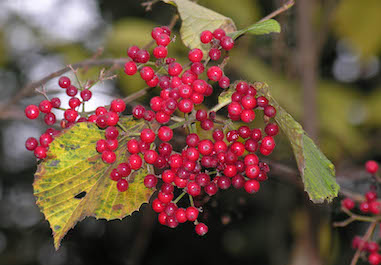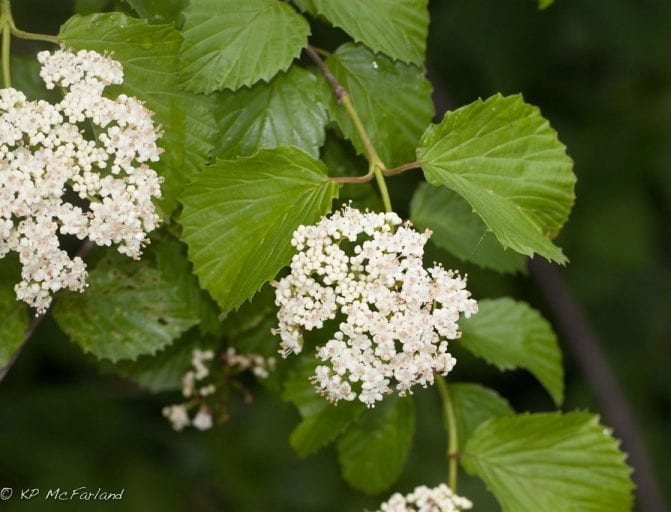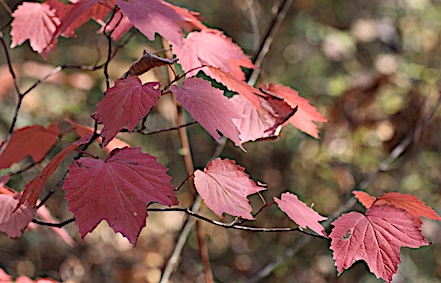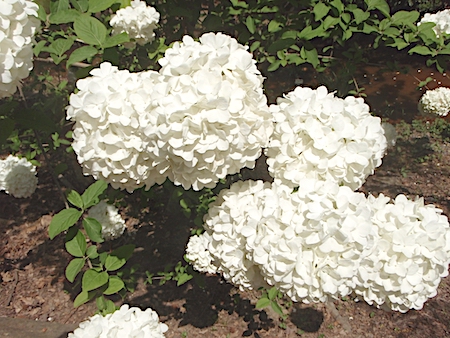Viburnum: A Cornucopia of Natural Delights
By Alice Slayton Clark, Fairfax Master Gardener
Whether in your neighbor’s garden or in the wild, viburnums are all around and one of the most diverse, beautiful and often sweetly scented plants in our region. There are more than 150 species of viburnum worldwide, with many native to the mid-Atlantic. They are wonderous in form and flower, ranging from small shrubs to understory trees, deciduous to evergreen, with creamy white/pinkish flowers, colorful berry clusters (drupes) and showy fall leaves. They please in all seasons as extolled by James Montgomery in his poem, The Laurustinus (Viburnum tinus).

Berries of Viburnum x burkwoodii
A genus in the family Adoxaceae, viburnums are hardy plants suitable to Northern Virginia growing Zones 7a and 7b. Most are fast-growing, some 1 to 2 feet per year (30-60 cm), forming attractive hedges or screens because of their size and density. Viburnums do best in slightly acidic (pH 5.5 to 6.5), rich soil, with 10 to 20 percent organic matter. Plants generally prefer a sunny/partly sunny spot (many like afternoon shade) to maximize flower production, and proximity to a different viburnum cultivar for cross pollination and enhanced fruit production. Keep plants tidy by removing dead canes or by thinning overgrowth in early spring. Only prune viburnums after flowering or risk losing blooms.
While mostly resistant to deer, viburnums are susceptible to some disease and pest problems. Powdery mildew and bacterial leaf spot are common, especially in damp growing conditions. Botryosphaeria dieback and canker and armillaria root rot can also occur. Plants also can be afflicted by aphids, leaf beetles, flower thrips, spider mites, scale, root weevils and nematodes. For further information on viburnum disease and pest controls, consult the Virginia Pest Management Guide.

Native Virburnum dentatum
If you would like to incorporate viburnum into your landscape and prefer a native plant, there are several varieties for you to consider. Viburnum dentatum (Arrowwood) is a deciduous shrub (drops its leaves in winter), reaching a height of 15 feet (4.5 m) tall under the best growing conditions. It tolerates a range of soil and moisture conditions, growing in full or partial sun, with scentless blooms, black berries and glossy leaves. Although not flashy, V. dentatum is a hardy specimen that makes a good hedge with fall foliage of yellow, orange or red.
Another deciduous, hearty and adaptable native, Viburnum lentago (Nannyberry) grows to 18 feet tall (5.5 m) and 12 feet wide (3.5 m), tolerating a range of soils, moisture and lighting conditions (full or partial sun). It blooms in May, exhibiting 3- to 5-inch (7 to 12 cm) flower clusters and black berries that can last for months and providing visual interest and food for birds well into the winter. Take note, however, that overripe Nannyberry fruit can have a musty smell similar to wet wool.
A good candidate for wet yards is the Viburnum nudum (Possumhaw), a multi-stemmed rounded bush that reaches 5 by 12 feet tall and wide (1.5 by 3.5 m). It has an attractive fruit display with light pink berries that fade to black and are tasty to songbirds. Its fall foliage casts a lovely hue of purplish red. Be aware, however, that this cultivar can attract some deer browsing.

Fall coloring of Viburnum acerifolium
The foliage of the Viburnum acerifolium (Mapleleaf) is also very attractive, especially its maple-shaped leaf. This shrub remains small, about 5 by 4 feet, and can thrive in full shade and dry soils. It is common to see V. acerifolium growing throughout the wooded areas in Fairfax County, with small white flowers in early summer followed by red berries and reddish fall coloring. It, along with V. nudum, V. dentatum, and V. lentago, all host the blue azure butterfly (Celastrina ladon).
For a different look, Viburnum prunifolium (Blackhaw), a multi-stemmed, larger native (12 by 15 feet) can be pruned into a single stem, small tree that reaches up to 30 feet tall (9 m). It blooms from May to June, with non-fragrant flowers and edible yellow berries that can be made into jams. Like other natives, V. prunifolium is quite hardy, pest-resistant and attractive to local birds, bees and small mammals. Its bark was formerly used as a medicinal treatment for things like menstrual cramps (dysmenorrhea), although there is no scientific evidence today to support this use.
If you are looking for something more ornamental, the following viburnum cultivars are popular in home gardens. Viburnum carlesii (Mayflower or Korean spice) grows to 6 feet tall (1.5 m) and wide and flaunts pinkish white snowball flowers in early spring that carry a very fragrant, clove-like scent. V. carlesii grows best in full sun to partial shade, sporting red berries and purple fall foliage. Popular cultivars include ‘Cayuga’ and ‘Compactum,’ the latter a dense plant reaching 3 feet tall and wide over 10 years.

Flowers of Viburnum macrocephalum
Viburnum macrocephalum (Chinese snowball) is a dense shrub, reaching 12 to 20 feet tall (3.5 to 6 m) with impressive 6 to 8 inch (15 to 20 cm) flower clusters that display March through April. As the blooms mature, the color morphs from green to white but do not yield berries. V. macrocephalum does best in full sun with afternoon shade and often reblooms in late summer.
For evergreen or semi-evergreen plants, try Viburnum × rhytidophylloides ‘Willowwood’ or ‘Allegheny,’ or Viburnum × burkwoodii ‘Anne Russell’ or ‘Mohawk.’ V. x rhytidophylloides can reach 10 feet tall planted in full sun, sporting leathery leaves that are dark on top and grey underneath. ‘Willowwood‘ is characterized by arching branches compared to ‘Allegheny’ which has a more rounded look. Flowers flush in April, with ‘Willowwood’ known to rebloom in fall. V. × burkwoodii can also reach 10 feet tall (3 m) and wide, has 2- to 3-inch (5 to 7.5 cm) spicy scented flower clusters and red berries that fade to black in fall. A hearty plant, it can tolerate air pollution making it a good fit for more urban landscapes.

Foliage of Viburnum awabuki ‘Chindo’
A taller evergreen, Viburnum awabuki can grow to 20 feet tall (6 m) and 15 feet (4.5 m) wide in sun or shade. It sports large, shiny, saw-toothed leaves, and the ‘Chindo’ cultivar yields an abundance of bright red berries. Be aware that V. awabuki can be damaged by cold temperatures below 10 F (-12 C).
With so many to cultivars to choose from, pick a favorite, plant your shrub and enjoy the pageantry! You will be sharing the experience with the Eastern Bluebird, Northern Flicker, Gray Catbird and American Robin who feast on the berries, while butterflies, bees and moths soak up the floral display. Your viburnum may even play host to the caterpillars of the hummingbird moth (Hemaris thysbe), a complete cornucopia of natural delight.
When all around is dead and dry;
Whose ruby buds, though storms are louring,
Spread their white blossoms to the sky.
(excerpt from The Laurustinus, by James Montgomery [1771-1854])
…updated 2024
- References
- Viburnum Factsheet, Marjan Kluepfel and Bob Polomski, Clemson Cooperative Extension
- Viburnum — A Shrub for Many Settings, Susan Martin, Piedmont Master Gardeners
- Guide to Identifying Viburnums, Lori Brewer (project coordinator), Department of Horticulture, Cornell
University - Viburnum Diseases & Insect Pests, Joey Williamson, Clemson Cooperative Extension
- Viburnum Plant Health Problems, The Connecticut Agricultural Experiment Station
- Home Grounds and Animals, Pest Management Guide, Virginia Cooperative Extension